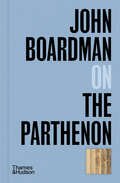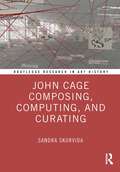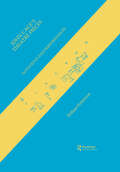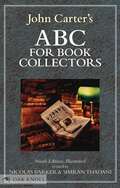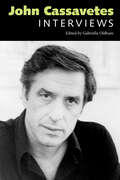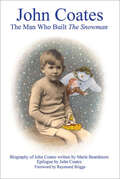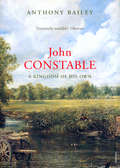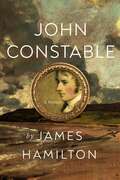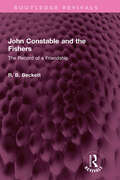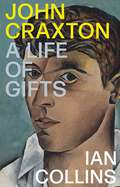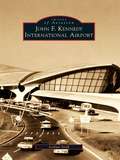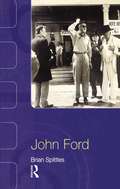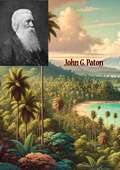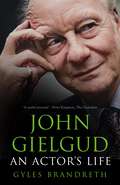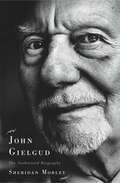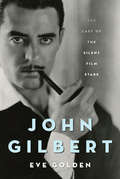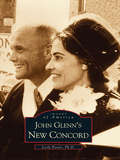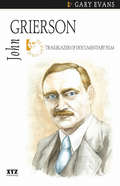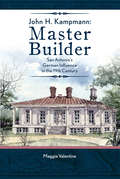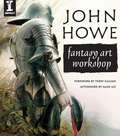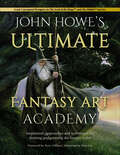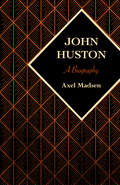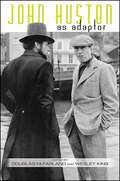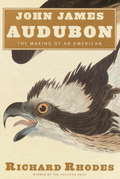- Table View
- List View
John Boardman on the Parthenon (Pocket Perspectives #2)
by John BoardmanBritain's most distinguished historian of ancient Greek art recounts what the Parthenon and its sculptures meant to the citizens of fifth-century BCE Athens. Surprising, questioning, challenging, enriching: the Pocket Perspectives series presents timeless works by writers and thinkers who have shaped the conversation across the arts, visual culture, and history. Celebrating the undiminished vitality of their ideas today, these covetable and collectable little books embody the best of Thames & Hudson.
John Cage Composing, Computing, and Curating (Routledge Research in Art History)
by Sandra SkurvidaThis study reassesses Cage’s multifaceted practice from a transdisciplinary perspective, using text as a premise for his musical, visual, lingual, and museal compositions.In his compositions, John Cage opened the structures of music, language, and the museum to change perpetuated by chance operations. His correspondences across history with an extended circle of creators, including Erik Satie, Marcel Duchamp, and Henry David Thoreau, among many others, erased single-minded authorship via methodical processing of source material. Foreshadowing ecological recycling, Cage’s late compositions for museum opened perspectives for posthuman mediation in curating and contemporary art. He conceived of anarchy as the coexistence of mutually aiding yet autonomous self-determinate entities. This book introduces Cage to the twenty-first century as a composer whose work intersects different temporalities and modes of being, the past and the present, the human and the non-human, and the individual and the communal.The book will be of interest to scholars of art history, music, curatorial studies, and museum studies.
John Cage's Theatre Pieces (Contemporary Music Studies #Vol. 11.)
by William FettermanThe experimental composer John Cage (1912-1992) is best known for his works in percussion, prepared piano, and electronic music, but he is also acknowledged to be one of the most significant figures in 20th century theatre. In Cage's work in theatre composition there is a blurring of the distinctions between music, dance, literature, art and everyday life. Here, William Fetterman examines the majority of those compositions by Cage which are audial as well as visual in content, beginning with his first work in this genre in 1952, and continuing through 1992.Much of the information in this study comes from previously undocumented material discovered among the unpublished scores and notes of Cage and his frequent collaborator David Tudor, as well as author's interviews with Cage and with individuals closely associated with his work, including David Tudor, Merce Cunningham, Bonnie Bird, Mary Caroline Richards, and Ellsworth Snyder.
John Carter's ABC for Book Collectors
by John Carter Nicolas Barker Simran ThadaniThis ninth edition has been thoroughly revised and re-edited by Nicolas Barker, former Editor of The Book Collector, and Simran Thadani, Executive Director of Letterform Archive. With a new Introduction, it incorporates new terms, additions and amendments and, for the first time, illustrations in black & white and color. Nicolas Barker worked with his friend John Carter revising the ABC up to the latter's death in 1975 and has faithfully preserved the spirit of the original. ABC for Book Collectors, while keeping us up-to-date with modern terminology, retains its humorous character and importance as the one indispensable guide to book collecting.
John Cassavetes: Interviews (Conversations with Filmmakers Series)
by Gabriella OldhamAmerican filmmaker John Cassavetes (1929-1989) made only nine independent films during a quarter century, but those films affected the cinema culture of the 1960s to the 1980s in unprecedented ways. With a close nucleus of actors and crew members on his team, including his wife Gena Rowlands, Peter Falk, and Ben Gazzara, Cassavetes created films that explored the gritty side of human relationships. He staunchly advocated the right of actors and filmmakers to full artistic freedom over their work. Attracting both fervent admirers and harsh critics, Cassavetes's films have garnered prestigious awards in the US and Europe and continue to evoke strong reactions.Starting in New York with his first film Shadows (1959), Cassavetes moved on to the West Coast with Faces (1968), Husbands (1970), Minnie and Moskowitz (1971), A Woman Under the Influence (1974), The Killing of a Chinese Bookie (1976), Opening Night (1977), Gloria (1980), and Love Streams (1984). He also directed several studio films, which often rankled his independent streak that rebelled against a loss of artistic freedom. Cassavetes's work in the theater and his performances in numerous television programs and films, including The Dirty Dozen (1967) and Rosemary's Baby (1968), made him, as a director, fiercely protective of his actors' right to self-expression.Cassavetes's contributions to film as actor, writer, director, producer, and cinematographer at a time of radical changes in cinema history continue to inspire independent filmmakers to challenge creative restrictions and celebrate actors' artistic contributions. John Cassavetes: Interviews captures this "maverick" streak of an intensely personal filmmaker who was passionate about his art.
John Coates: The Man Who Built The Snowman
by Marie BeardmoreAn abundantly illustrated biography of the British animation producer behind Yellow Submarine, The Snowman, and other classics.John Coates is best known as the producer of The Snowman, When the Wind Blows, Wind in the Willows, Willows in Winter, and Famous Fred—and as the man behind the Beatles film Yellow Submarine. In his long, eventful career, he earned a BAFTA and a CableACE Award as well as Primetime Emmy and Academy Award nominations.This intimate biography takes us on a journey through Coates’s youth, his years as an army officer in the 11th Hussars in World War II, and his postwar life, working as a distributor for Rank Films throughout Asia before returning to England and eventually taking over TVC’s animation studio.With a foreword by Raymond Briggs and an epilogue by John Coates
John Constable: A Kingdom of his Own
by Anthony BaileyBorn in 1776 in East Anglia near the river Stour, John Constable was destined for his father's business of milling and grain-shipping. But he was obdurately opposed to this and persuaded his family he should become an artist instead. In the same determined spirit, he wooed Maria Bicknell in the teeth of opposition from her formidable grandfather, and persisted in painting landscapes at a time when history paintings and portraits were the fashion. Sometimes sharp and sarcastic, and often depressed, Constable in fact possessed a warm gift for intimate friendship. This is revealed in his letters to John Dunthorne, village handyman and housepainter, and to his best friend and patron, archdeacon John Fisher, to whom he wrote: 'I have a kingdom of my own, both fertile and populous - my landscape and my children'. In recent times, after a period of relative ignominy, Constable's influence on British landscape painting has been re-acknowledged, he has been more widely exhibited and his reputation has been reestablished as one of the masters of his genre. This important and absorbing biography explores his life and work, and highlights the dramatic tension between the two.
John Constable: A Portrait
by James HamiltonA fresh and lively biography of the revolutionary landscape painter John Constable.John Constable, who captured the landscapes and skies of southern England in a way never before seen on canvas, is beloved but little-understood artist. His paintings reflect visions of landscape that shocked and perplexed his contemporaries: attentive to detail, spontaneous in gesture, brave in their use of color. His landscapes show that he had sharp local knowledge of the environment. His skyscapes show a clarity of expression rarely seen in other artist's work. The figures within show an understanding of the human tides of his time. And his late paintings of Salisbury Cathedral show a rare ability to transform silent, suppressed passion into paint. Constable was also an active and energetic correspondent. His letters and diaries reveal a man of opinion, passion, and discord. His letters also reveal the lives and circumstances of his extended family who serve to define the social and economic landscape against which he can be most clearly seen. These multifaceted reflections draw a sharp picture of the person, as well as the painter. James Hamilton's biography reveals a complex and troubled man. Hamilton's portrait explodes previous mythologies about this timeless artist and establishes him in his proper context as a giant of European art.
John Constable and the Fishers: The Record of a Friendship (Routledge Revivals)
by R B BeckettFirst published in 1952, John Constable and the Fishers is based on original letters which have never been published in full before. These have been woven into a connected narrative dealing with the friendship which existed between Constable and various members of the Fisher family, more particularly the Bishop of Salisbury (a personal friend of George III who entrusted him with the education of Princess Charlotte as heiress to the throne) and his nephew the Archdeacon of Berkshire. The Archdeacon’s letters give a picture of life in a cathedral closed and country vicarages, reminiscent of Trollope’s Barchester and Thomas Hardy’s Wessex. In return Constable confides his ideals and ambitions; and as Mr. Grigson suggests in his introduction, the encouragement he received from the Fishers may have had a decisive effect on the future of landscape art. The letters are fully annotated and are illustrated with connected works done by Constable. This book will of interest to students of history, art and literature.
John Craxton: A Life of Gifts
by Ian CollinsUplifting and engaging, this story recounts the life and career of a rebellious 20th-century British artistBorn into a large, musical, and bohemian family in London, the British artist John Craxton (1922–2009) has been described as a Neo-Romantic, but he called himself a “kind of Arcadian”. His early art was influenced by Blake, Palmer, Miró, and Picasso. After achieving a dream of moving to Greece, his work evolved as a personal response to Byzantine mosaics, El Greco, and the art of Greek life. This book tells his adventurous story for the first time. At turns exciting, funny, and poignant, the saga is enlivened by Craxton’s ebullient pictures. Ian Collins expands our understanding of the artist greatly—including an in-depth exploration of the storied, complicated friendship between Craxton and Lucian Freud, drawing on letters and memories that Craxton wanted to remain private until after his death.
John F. Kennedy International Airport (Images of Aviation)
by Joshua StoffJohn F. Kennedy International Airport opened in 1948, after the realization set in that the newly built LaGuardia Airport was unable to handle the volume of air traffic for New York City. Pushed through by New York's Mayor Fiorello LaGuardia, the airport was to be located 14 miles from Manhattan, in Jamaica Bay, Queens, on the site of the old Idlewild Golf Course. For its first years, Idlewild Airport, as it was originally known, consisted of a low-budget temporary terminal and a series of Quonset huts. A major new building program began in the mid-1950s, and the airport rapidly changed from a ramshackle series of buildings into a glamorous-looking city. Renamed John F. Kennedy International Airport in 1963, it has now grown to cover 5,000 acres.
John Fawcett's Ginger Snaps
by Ernest MathijsFew studies of Canadian cinema to date have engaged deeply with genre cinema and its connection to Canadian culture. Ernest Mathijs does just that in this volume, which traces the inception, production, and reception of Canada's internationally renowned horror film, Ginger Snaps (2000). This tongue-in-cheek Gothic film, which centres on two death-obsessed teenage sisters, draws a provocative connection between werewolf monstrosity and female adolescence and boasts a dedicated world-wide fan base.The first book-length study of this popular film, John Fawcett's Ginger Snaps is based on the author's privileged access to most of its cast and crew and to its enthusiasts around the world. Examining themes of genre, feminism, identity, and adolescent belonging, Mathijs concludes that Ginger Snaps deserves to be recognized as part of the Canadian canon, and that it is a model example of the kind of crossover cult film that remains unjustly undervalued by film scholars.
John Ford (On Directors)
by Brian SpittlesJohn Ford is a monumental figure in Hollywood and world cinema. Throughout his long and varied career spanning the silent and sound era, he produced nearly 150 films of which Iron Horse (1924), Stagecoach (1939), The Grapes of Wrath (1940), How Green Was My Valley (1941), The Searchers (1956) and The Man Who Shot Liberty Valance (1962) are classics of cinema. Ford was also an influential figure in developing, and extending Hollywood's traditions. Stylistically Ford was instrumental in developing new camera techniques, atmospheric lighting and diverse narrative devices. Thematically, long before it became conventional wisdom, Ford was exploring issues that concern us today, such as gender, race, the treatment of ethnic minorities and social outcasts, the nature of history and the relationship of myth and reality. For all these reasons, John Ford the man and his films reward thought and study, both for the general reader and the academic student. Ford's pictures express the world in which they were made, and have contributed to making what Hollywood is today. This book illustrates the excitement, importance, influence, creativity, deviousness and complexity of the man and his films.
John G. Paton
by John G. PatonThe Autobiography of John G. Paton recounts the extraordinary life and missionary work of John G. Paton, a 19th-century Scottish missionary who devoted much of his life to spreading Christianity among the indigenous peoples of the New Hebrides (modern-day Vanuatu). This deeply personal and inspiring memoir captures the challenges, triumphs, and unwavering faith that defined Paton’s work in one of the most remote and dangerous mission fields of his time.The narrative begins with Paton’s early life in Scotland, where he grew up in a devout Christian household that shaped his lifelong calling to serve others. He shares his struggles and successes in becoming a missionary and the profound sense of purpose that drove him to leave behind the familiar comforts of home for the harsh realities of missionary life among island communities known for their resistance to foreign influence.Paton’s experiences in the New Hebrides are both harrowing and inspiring. He recounts narrow escapes from danger, confrontations with local tribal customs, and the heartbreak of personal losses, including the deaths of his wife and child. Despite the hardships, his story is also one of hope, as he witnesses profound changes in the lives of the people he serves, including their gradual acceptance of Christianity.This autobiography is more than a missionary journal—it reflects on themes of perseverance, cultural exchange, and the power of faith in the face of adversity. Paton’s accounts offer valuable insight into the complexities of 19th-century missionary work, balancing his religious zeal with respect for the people he sought to convert.The Autobiography of John G. Paton remains a timeless testament to the courage, conviction, and compassion of one man’s mission. It continues to resonate with readers interested in missionary history, Christian faith, and stories of cross-cultural engagement and endurance.
John Gielgud: An Actor's Life
by Gyles Brandreth‘A sense of delight permeates Gyles Brandreth’s John Gielgud: An Actor’s Life … Brandreth combines neat reportage, deft evocation and lovely tales about a man he knew and relished.’ – The Times‘A delightful memoir which tells you all you need to know and collects all the anecdotes.’ – Daily MailJohn Gielgud was born in April 1904. When he died in May 2000, he was honoured as ‘the giant of twentieth-century theatre’. In this updated, acclaimed biography, Gyles Brandreth draws from over thirty years of conversations with Gielgud to tell the extraordinary story of a unique actor, film star, director and raconteur.In 1921 Gielgud made his first appearance at the Old Vic in London and through the next eight decades he dominated his profession – initially as a classical actor, later in plays by Harold Pinter and Alan Bennett. In his twenties he had appeared in silent movies; more than half a century later, he emerged as a Hollywood star, winning his first Oscar at the age of seventy-eight.With wonderful anecdotes, and contributions from Kenneth Branagh, Alec Guinness, Paul Scofield, Donald Sinden, Judi Dench and Peter Hall, John Gielgud: An Actor’s Life is a compelling, humorous and moving account of a remarkable man.
John Gielgud: The Authorized Biography
by Sheridan MorleySir John Gielgud's career as an actor was perhaps the most distinguished of any of his generation, and, in a lifetime that spanned almost a century, he appeared in hundreds of theatrical productions and films, receiving virtually every honor given, including an Academy Award.Now, in this wonderfully insightful biography, fully authorized and written with first-ever access to Gielgud's personal letters and diaries, bestselling biographer Sheridan Morley not only traces the actor's fascinating career, but provides a fresh and remarkably frank look into John Gielgud the man, showing how his success as an actor in many ways came at the expense of his personal happiness.Born into a theatrical family, John Gielgud took to the stage as naturally as a duck to water, and almost from the beginning, those who saw him perform knew that they were experiencing something extraordinary. A determined actor, intent on learning and polishing his craft, he worked incessantly, taking on one role after another, the greater the challenge, the better.During his long and remarkable career, he took on every truly great and demanding role, including all of Shakespeare's major plays as well as many contemporary and experimental productions. At ease in both great drama and light comedy, he was blessed with a great range and a seemingly infinite capacity to inhabit whatever character he attempted.Basically a somewhat shy man offstage, however, Gielgud for the most part limited his friendships to those with whom he worked, and as a result the theater -- and later, film -- made up just about his entire life. That he was flesh and blood, however, was reflected in the fact that he did enter into two long-term relationships, the first with a man who eventually left him for another, but with whom Gielgud maintained a strong tie, and the second with a handsome, mysterious Hungarian who lived with him until he died, just a few months before Sir John.True scandal came into Gielgud's life only once. In 1953, just weeks after Gielgud had been knighted by the Queen, he was arrested in a public men's room and charged with solicitation. The British press had a field day, but Gielgud's friends and fellow actors rallied to his support, as did his thousands of fans, and the result was the eventual change of law in England regarding sex between consenting adults.While these and many other aspects of his personal life are discussed for the first time in this distinguished biography, it is Gielgud's career as an actor, of course, that receives the greatest attention. And while British audiences had the pleasure of seeing him perform in the theater for his entire life, Americans came to know him best for his work in the movies, and most especially for his Oscar-winning performance as Hobson the butler in the Dudley Moore film Arthur.As dramatic and captivating as one of Sir John's many performances, this authorized biography is an intimate and fully rounded portrait of an unforgettable actor and a remarkable man.
John Gilbert: The Last of the Silent Film Stars (Screen Classics)
by Eve GoldenThis revealing biography of the legendary silent film star chronicles his meteoric rise, famous romances, and tragic descent into obscurity. Known as &“The Great Lover,&” John Gilbert was among the world's most recognizable actors during the silent era. A swashbuckling figure on screen and off, he is best known today for his high-profile romances with Greta Garbo and Marlene Dietrich, his legendary conflicts with Louis B. Mayer, his four tumultuous marriages, and his swift decline after the introduction of talkies. Many myths have developed around the larger-than-life star in the eighty years since his untimely death, but this definitive biography sets the record straight. Eve Golden separates fact from fiction in John Gilbert, tracing the actor's life from his youth spent traveling with his mother in acting troupes to the peak of fame at MGM, where he starred opposite Mae Murray, Norma Shearer, Joan Crawford, Greta Garbo, and others in popular films such as The Merry Widow, The Big Parade, Flesh and the Devil, and Love. Golden debunks some of the most pernicious rumors about Gilbert, including the oft-repeated myth that he had a high-pitched, squeaky voice that ruined his career. Meticulous, comprehensive, and generously illustrated, this book provides a behind-the-scenes look at one of the silent era's greatest stars and the glamorous yet brutal world in which he lived.
John Glenn's New Concord (Images of America)
by Lorle PorterI've always believed that New Concord and Muskingum College are the center of the universe, because if you get your start here, you can go anywhere. This quote from John Herschel Glenn Jr. is the perfect summation of a wonderfully Midwestern town that produced one of the great American citizens of all time. The Village of New Concord, founded in 1828, had humble enough beginnings. Over the course of the next century and a half, however, the growth of the entire country was played out on New Concord's stage as residents faced a series of revolutionary frontiers: Zane's Trace, the National Road, U.S. Route 40, Interstate 70, and finally, space. New Concord, like the rest of the country, struggled through two world wars, the Great Depression, and social turmoil. Unlike the rest of the country, it also produced a hero.
John Grierson
by Gary EvansJohn Grierson, founder of both the British documentary film movement and the National Film Board of Canada, was one of the twentieth centurys most influential personalities in film culture. He gave the word "documentary" to the English language.
John H. Kampmann, Master Builder: San Antonio's German Influence in the 19th Century
by Maggie ValentineAlthough relatively unknown in modern day San Antonio, John H. Kampmann was an imposing force during his lifetime (1819-1885). Maggie Valentine explores the lasting legacy Kampmann had as a craftsman, builder, contractor, stonemason, construction supervisor, building designer, materials supplier, and business and civic leader for thirty-five years in San Antonio. He changed the face of the city from an adobe Spanish village to a city of stone and mortar. The book also looks at what it meant to be an architect, the business of building, and the role of immigrants. John and Caroline Bonnet Kampmann's descendants contributed much to the history of the city for generations. His client list reads like a Who's Who in 19th-century San Antonio. His work included the Menger Hotel, St. Joseph's Catholic Church, St. Mark's Episcopal Church, and the German-English School, as well as the Steves, Eagar, Halff, Groos, and Oppenheimer Houses. In addition he ran businesses from a bank to a brewery, and served as city alderman and fire captain. This study brings to light an important chapter in the formation of the urban fabric of San Antonio and its evolution into a multi-cultural community. Valentine explores the built environment as it exemplified the social, political, and economic history.
John Howe Fantasy Art Workshop
by John Howe''Here's how I do it, and why''This is the premise behind John Howe's first practical exploration of his artistic inspirations, approaches and techniques. This title will appeal to practical artists and fans of John Howe's work by providing step-by-step demonstrations, sketches and oustanding finished paintings, some designed specifically for this book. It covers a wide range of subjects essential to any aspiring fantasy artist, including materials and the creative process, and drawing and painting humans, beasts, landscapes and architecture. The final section of the book provides further inspiration and guidance on presenting work in various forms including film work, book covers and advertising, all areas John Howe has vast experience in. It includes a foreword written by groundbreaking film director, Terry Gilliam, with an Afterword by Alan Lee, the Oscar winning world-class illustrator.
John Howe's Ultimate Fantasy Art Academy: Inspiration, approaches and techniques for drawing and painting the fantasy realm
by John HoweCreate your own fantasy art with this comprehensive guidebook by the lead conceptual designer on The Lord of the RingsTM and The HobbitTM trilogies. Discover the creative processes and intriguing inspirations behind the work of John Howe – lead conceptual designer on The Lord of the RingsTM and The HobbitTM movie trilogies. Through step-by-step drawings and finished paintings, Howe reveals his artistic approach in action: from developing characters to creating atmospheric landscapes, extraordinary architecture and fantasy beasts. In this practical guide, Howe shares tips on everything from building a portfolio to book illustration, graphic novels and designing for the big screen. Develop your own personal style of fantasy art with help from the best in the business with this must-have book. Features a foreword by groundbreaking film director Terry Gilliam, and an afterword by Alan Lee, John&’s partner on the conceptual design for The Lord of the RingsTM movie trilogy and Oscar-winning illustrator.
John Huston
by Axel MadsenThe first major biography of the famous and controversial director John Huston, whose thirty-seven films--including The Maltese Falcon, Key Largo, and The African Queen--are considered classics and garnered him fifteen Academy Award nominations and two wins.
John Huston as Adaptor: John Huston As Adaptor P (SUNY series, Horizons of Cinema)
by Douglas McFarland; Wesley KingJohn Huston as Adaptor makes the case that adaptation is the salient element in Huston's identity as a filmmaker and that his early and deep attraction to the experience of reading informed his approach to film adaptation. Thirty-four of Huston's thirty-seven films were adaptations of literary texts, and they stand as serious interpretations of literary works that could only be made by an astute reader of literature. Indeed, Huston asserted that a film director should be above all else a reader and that reading itself should be the intellectual and emotional basis for filmmaking.The seventeen essays in this volume not only address Huston as an adaptor, but also offer an approach to adaptation studies that has been largely overlooked. How an adaptor reads, the works to which he is drawn, and how his literary interpretations can be brought to the screen without relegating film to a subservient role are some of the issues addressed by the contributors. An introductory chapter identifies Huston as the quintessential Hollywood adaptor and argues that his skill at adaptation is the mark of his authorial signature. The chapters that follow focus on fifteen of Huston's most important films, including The Maltese Falcon (1941), The Treasure of the Sierra Madre (1948), The African Queen (1951), The Night of the Iguana (1964), Under the Volcano (1984), and The Dead (1987), and are divided into three areas: aesthetics and textuality; history and social context; and theory and psychoanalysis. By offering a more comprehensive account of the centrality of adaptation to Huston's films, John Huston as Adaptor offers a greater understanding of Huston as a filmmaker.
John James Audubon: The Making of an American
by Richard RhodesAn award-winning author who has frequently explored science and American history offers the first major new biography in many years of ornithologist/artist John James Audubon (1785-1851). Rhodes traces Audubon's arrival in America from France, his (for a time) commuter marriage, and career culminating in his magnum opus The Birds of America. He presents a well-rounded portrait of the Audubon Society's namesake and the U. S. of the early frontier period. Illustrations include color plates of Audubon's celebrated watercolors of North American birds. Annotation ©2004 Book News, Inc. , Portland, OR (booknews. com)
